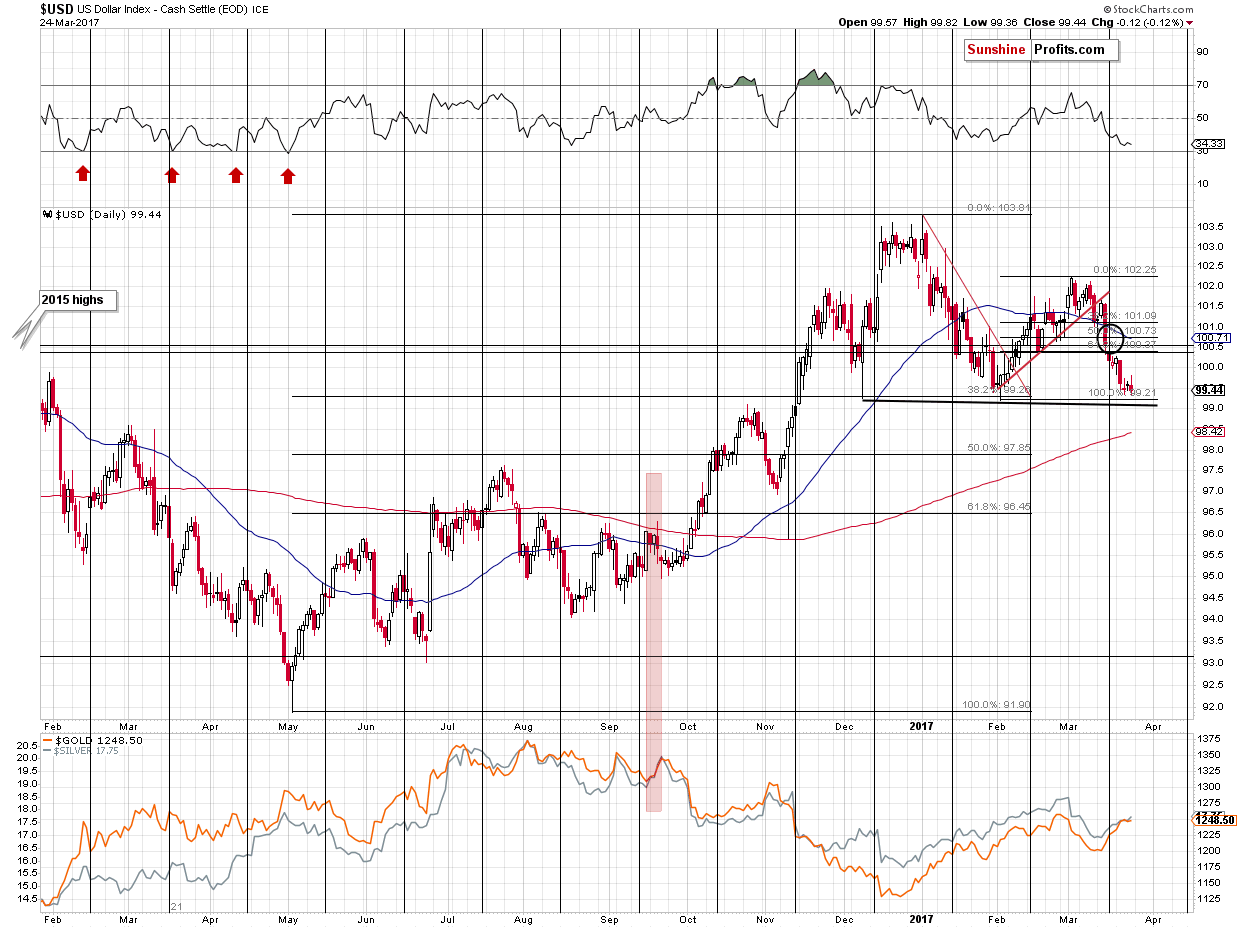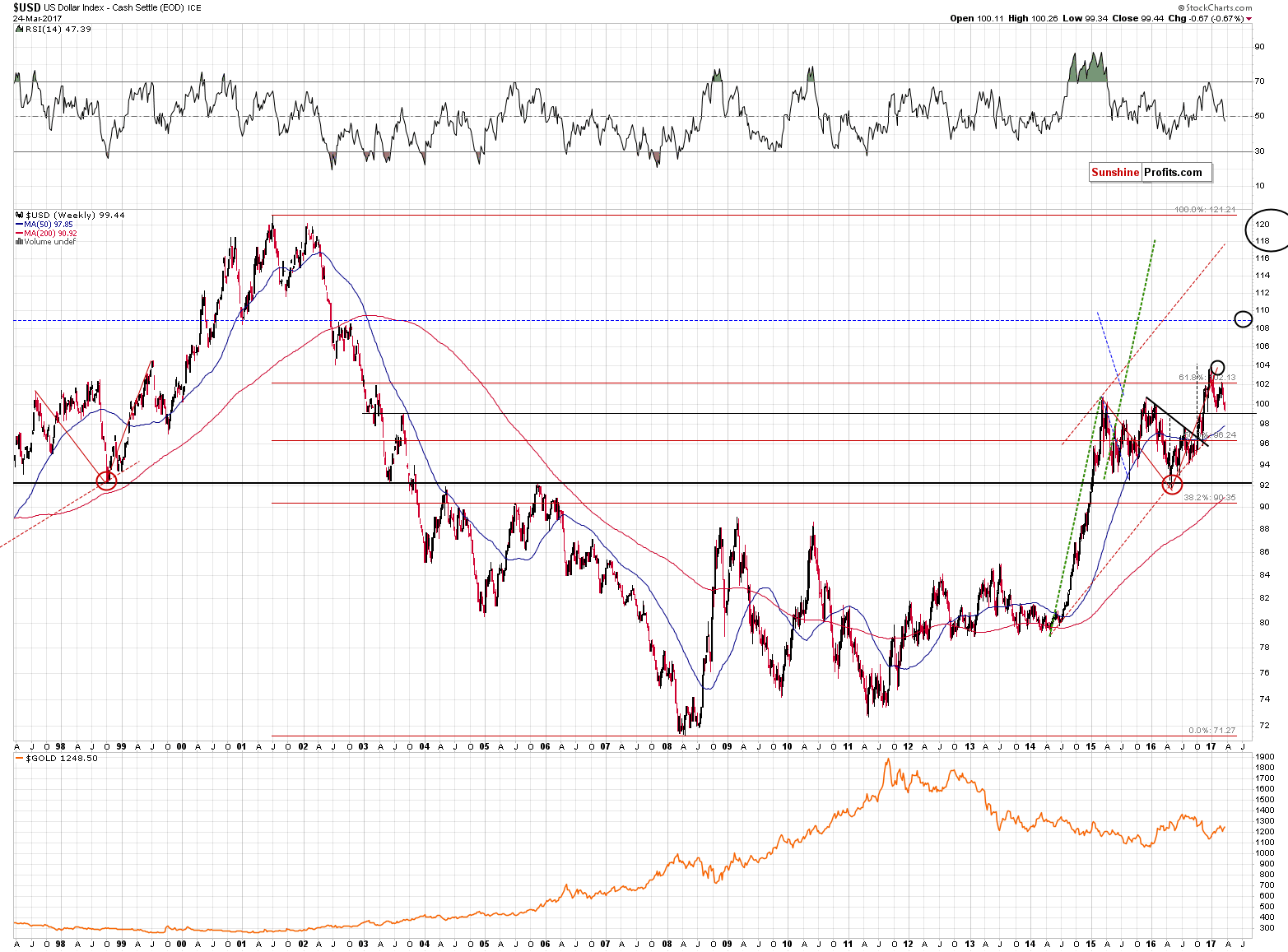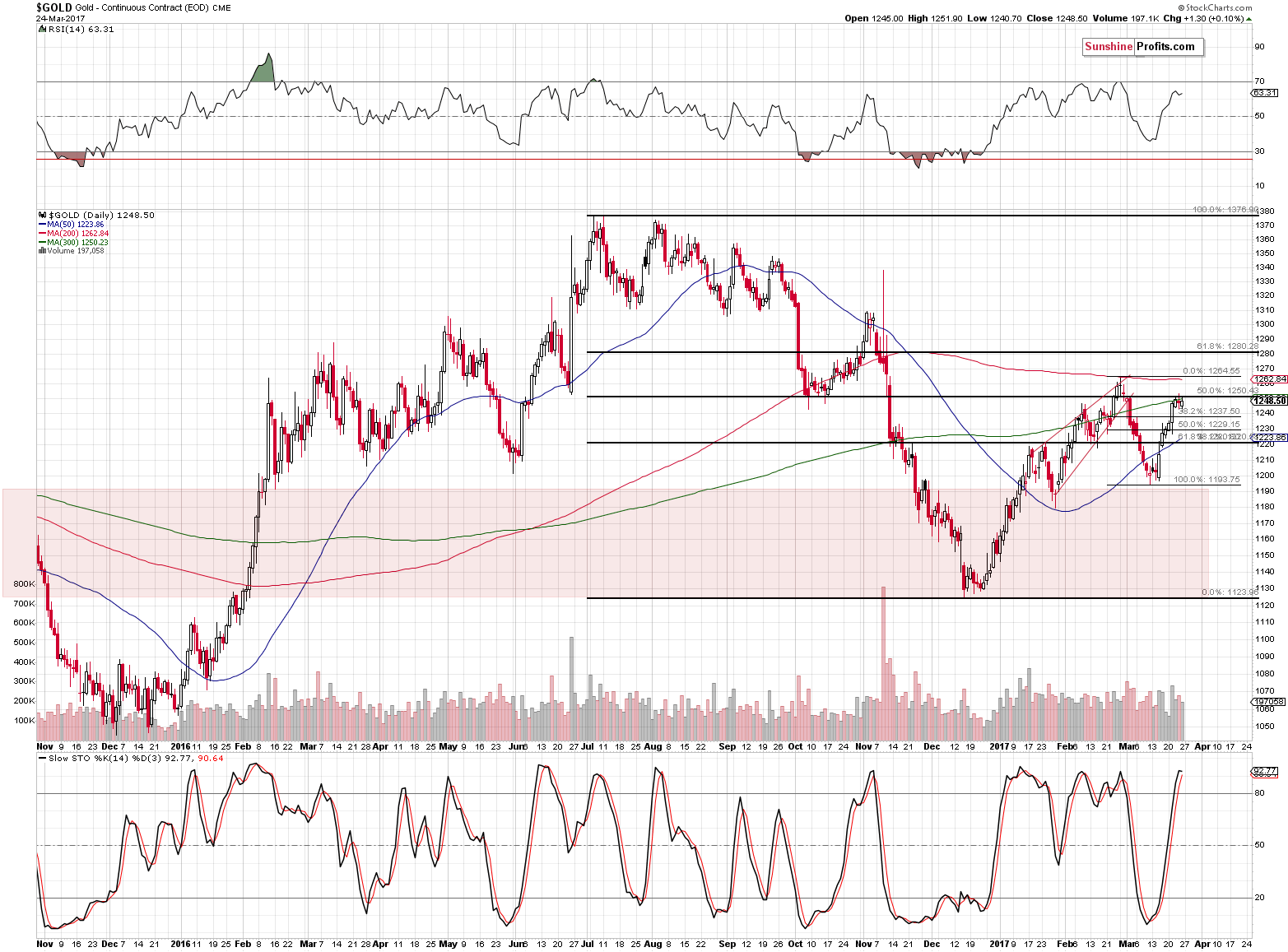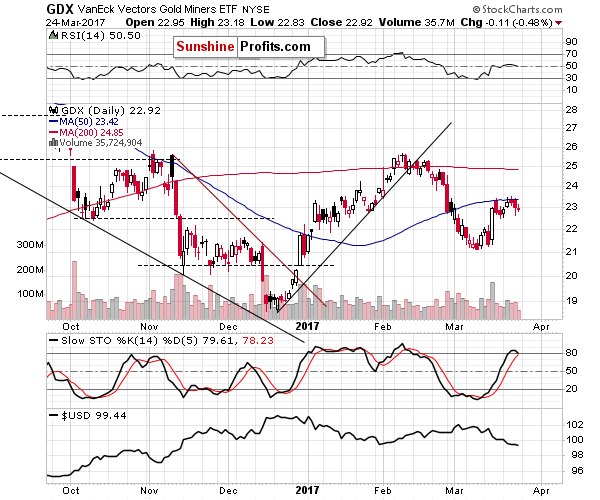Briefly: In our opinion, full (150% of the regular full position) speculative short positions in gold, silver and mining stocks are justified from the risk/reward perspective. This position was originally featured on Jan. 12, 2017 at 3:49PM.
Not much happened on Friday (except for silver’s outperformance), but today’s pre-market trading was quite rich in events. Gold moved to its February high, silver moved to $18, and the USD Index declined to the 99 level (thus moving to new lows). What are the implications?
Let’s start with the USD Index (charts courtesy of http://stockcharts.com).

Today’s move to 99 is a small breakdown below the previous lows. Because the move is relatively small and the session in the U.S. is far from being over, it is definitely not confirmed. In fact, it could be quickly erased and the supposedly bearish event could turn into an invalidation of the breakdown, which would be a very bullish sign. For now, today’s move is not something that changes the short-term outlook.

It doesn’t change the long-term outlook either. On Wednesday, we wrote the following:
We featured the above chart numerous times in the past several weeks while discussing the reflective nature of the current rally in the USD Index. Today, we added a new horizontal line that shows the level at which the 2002 – early 2013 decline ended. It was approximately… 99.2. The USD Index had already reached this level in early February, but a retest of this level doesn’t change anything from the technical perspective. In fact, since the previous decline ended at this level, the next huge upswing is likely to begin from this level or from levels close to it.
The above discusses the aspect of price. As far as the aspect of time is concerned, the early 2003 consolidation took about 3 months. The top of 2017 was formed on January 3rd, which – assuming similarity – would suggest that the time for the current consolidation is up or very close to being up. It appears that the time factor of this long-term similarity might be the thing that is really behind the decline that we’re seeing this month (answering the “Why did the USD decline despite an interest rate hike?” question). The USD Index might have not been ready to soar from the early February bottom as one month of consolidation wasn’t enough. As we are now approaching the three month milestone, the powerful rally is even more likely to begin relatively soon.
A huge rally in the USD Index is very likely to translate into a powerful slide in the precious metals prices. If gold is about to move below $1000 and possibly below $900, does it really matter if the slide starts at $1,230 or $1,250? Unless one engages in day-trading, then it’s not that important – whether the powerful decline is still coming or not is the key thing to focus on and the recent downswing in the USD Index doesn’t seem to have invalidated anything.
The difference between the mentioned level of 99.2 and the current value of the USD Index (approximately 99) is too small to invalidate the similarity to what happened in early 2003. Consequently, the analogy described above remains up-to-date and the implications remain bullish for the following weeks.

Gold moved to its February high and the 200-day moving average. Both are strong resistance levels and their combination is even stronger. Will it be enough to stop gold’s rally? It’s quite likely, especially that the volume on which gold moved higher on Friday was relatively low and this move was accompanied by silver’s outperformance (the white metal tends to outperform in the final parts of an upswing).

Speaking of relative performance, please note that mining stocks are not following gold higher, which is another strong bearish sign. GDX is currently trading at $23.5, which means that it simply moved to last week’s high – not above it.
Moreover, please note that mining stocks are not even close to their February highs, which proves that their underperformance is not only a one-day event.
Summing up, the move to the February high in gold might highlight this rally’s end just as the USD’s decline to 99 could mark the end of the decline in the U.S. dollar. The breakdown in the latter is far from being confirmed and the U.S. session has just started. The long-term analogy to 2002 and 2003 in the USD Index remains in place and the outlook for the following weeks remains bearish for the precious metals market.
As always, we will keep you – our subscribers – informed.
To summarize:
Trading capital (supplementary part of the portfolio; our opinion): Short positions (150% of the full position) in gold, silver and mining stocks are justified from the risk/reward perspective with the following stop-loss orders and initial target price levels / profit-take orders:
- Gold: exit-profit-take level: $1,063; stop-loss: $1,273; initial target price for the DGLD ETN: $81.88; stop-loss for the DGLD ETN $48.17
- Silver: initial target price: $13.12; stop-loss: $18.67; initial target price for the DSLV ETN: $46.18; stop-loss for the DSLV ETN $19.87
- Mining stocks (price levels for the GDX ETF): initial target price: $9.34; stop-loss: $26.34; initial target price for the DUST ETF: $143.56; stop-loss for the DUST ETF $21.37
In case one wants to bet on junior mining stocks' prices (we do not suggest doing so – we think senior mining stocks are more predictable in the case of short-term trades – if one wants to do it anyway, we provide the details), here are the stop-loss details and initial target prices:
- GDXJ ETF: initial target price: $14.13; stop-loss: $45.31
- JDST ETF: initial target price: $104.26; stop-loss: $10.78
Long-term capital (core part of the portfolio; our opinion): No positions (in other words: cash)
Insurance capital (core part of the portfolio; our opinion): Full position
Please note that the in the trading section we describe the situation for the day that the alert is posted. In other words, it we are writing about a speculative position, it means that it is up-to-date on the day it was posted. We are also featuring the initial target prices, so that you can decide whether keeping a position on a given day is something that is in tune with your approach (some moves are too small for medium-term traders and some might appear too big for day-traders).
Plus, you might want to read why our stop-loss orders are usually relatively far from the current price.
Please note that a full position doesn’t mean using all of the capital for a given trade. You will find details on our thoughts on gold portfolio structuring in the Key Insights section on our website.
As a reminder – “initial target price” means exactly that – an “initial” one, it’s not a price level at which we suggest closing positions. If this becomes the case (like it did in the previous trade) we will refer to these levels as levels of exit orders (exactly as we’ve done previously). Stop-loss levels, however, are naturally not “initial”, but something that, in our opinion, might be entered as an order.
Since it is impossible to synchronize target prices and stop-loss levels for all the ETFs and ETNs with the main markets that we provide these levels for (gold, silver and mining stocks – the GDX ETF), the stop-loss levels and target prices for other ETNs and ETF (among other: UGLD, DGLD, USLV, DSLV, NUGT, DUST, JNUG, JDST) are provided as supplementary, and not as “final”. This means that if a stop-loss or a target level is reached for any of the “additional instruments” (DGLD for instance), but not for the “main instrument” (gold in this case), we will view positions in both gold and DGLD as still open and the stop-loss for DGLD would have to be moved lower. On the other hand, if gold moves to a stop-loss level but DGLD doesn’t, then we will view both positions (in gold and DGLD) as closed. In other words, since it’s not possible to be 100% certain that each related instrument moves to a given level when the underlying instrument does, we can’t provide levels that would be binding. The levels that we do provide are our best estimate of the levels that will correspond to the levels in the underlying assets, but it will be the underlying assets that one will need to focus on regarding the signs pointing to closing a given position or keeping it open. We might adjust the levels in the “additional instruments” without adjusting the levels in the “main instruments”, which will simply mean that we have improved our estimation of these levels, not that we changed our outlook on the markets. We are already working on a tool that would update these levels on a daily basis for the most popular ETFs, ETNs and individual mining stocks.
Our preferred ways to invest in and to trade gold along with the reasoning can be found in the how to buy gold section. Additionally, our preferred ETFs and ETNs can be found in our Gold & Silver ETF Ranking.
As always, we'll keep you - our subscribers - updated should our views on the market change. We will continue to send out Gold & Silver Trading Alerts on each trading day and we will send additional Alerts whenever appropriate.
The trading position presented above is the netted version of positions based on subjective signals (opinion) from your Editor, and the Tools and Indicators.
As a reminder, Gold & Silver Trading Alerts are posted before or on each trading day (we usually post them before the opening bell, but we don't promise doing that each day). If there's anything urgent, we will send you an additional small alert before posting the main one.
=====
Latest Free Trading Alerts:
Demand for physical gold is allegedly collapsing. Is that true and what would it mean for the gold market?
Is Demand for Physical Gold Declining?
S&P 500 index lost 0.1% on Friday, following relatively volatile trading session. Expectations before the opening of today's trading session are negative, but will the market extend its almost month-long downtrend?
Stock Trading Alert: Negative Expectations Following Friday's Fluctuations
=====
Hand-picked precious-metals-related links:
PRECIOUS-Gold hits 1-mth top as Trump healthcare setback hurts dollar
World’s first seabed gold, copper, silver mine to begin production in 2019
=====
In other news:
Stock Futures Hit Six-Week Low on Failed Healthcare Bill
HSBC less dovish on Fed, now sees 2 more U.S. rate hikes this year
European Stocks Fall as Doubts Grow Over Trump's Tax-Cut Plans
=====
Thank you.
Sincerely,
Przemyslaw Radomski, CFA
Founder, Editor-in-chief, Gold & Silver Fund Manager
Gold & Silver Trading Alerts
Forex Trading Alerts
Oil Investment Updates
Oil Trading Alerts



